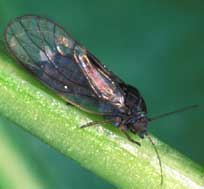Pear psylla management arsenal gets bigger
Entomology and Trevor Nichols Research Complex
If you didn’t get the results you expected from your pear psylla management program last year you aren’t alone. Insecticide resistance is common in psylla throughout the pear-growing areas of the world. These insects spend most of their time within pear orchards and can be exposed to repeated applications of the same handful of insecticides unless attention is given to rotation among chemical classes. The good news is that growers now have many choices for control options, making it easier to avoid treating successive generations with the same material or with materials that have the same modes of action.
Table 1 contains products that are labeled for psylla control in pears in Michigan. Listed for each table entry are the mode of action (MOA) group number as assigned by the Insecticide Resistance Action Committee, common name, trade name and insecticide class.
Materials that share the same number have the same mode of action even if followed by a different letter. For example, carbaryl has an MOA classification of 1A and diazinon of 1B. The number 1 indicates that both materials share the same MOA, in this case they are both cholinesterase inhibitors. The letter after the number represents the chemical sub-group. Notice that the last six table entries have no MOA classification and can be applied whenever appropriate for that material. A sound resistance management program relies on treating successive generations of psylla with materials from different MOA groups. Read the label directions for complete information regarding application rates, timing, combination with adjuvants and precautionary statements regarding effects on natural enemies and bees. Check the 2008 Michigan Fruit Management Guide for information on the effectiveness of many of the control options. Call the MSUE Bulletin office at 517-353-6740 to order a copy.

Pear psylla. Photo credit: J. Dykinga, USDA-ARS
Table 1. Insecticides labeled for pear psylla control in Michigan
| MOA Group1 | Common name | Trade name | Insecticide class |
|
1A
|
carbaryl
|
Sevin
|
carbamate
|
|
1B
|
azinphosmethyl
|
Azinphos-methyl,
|
organophosphate
|
|
1B
|
chlorpyrifos
|
Chlorpyrifos, Govern, Lorsban, Nufos, Warhawk, Whirlwind, Yuma
|
organophosphate
|
|
1B
|
diazinon
|
Diazinon
|
organophosphate
|
|
1B
|
dimethoate
|
Dimate
|
organophosphate
|
|
1B
|
methidathion
|
Supracide
|
organophosphate
|
|
2A
|
endosulfan
|
Endosulfan, Thionex
|
organochloride
|
|
3
|
deltamethrin
|
Battalion, Delta Gold, Decis
|
pyrethroid
|
|
3
|
esfenvalerate
|
Asana XL, Adjourn
|
pyrethroid
|
|
3
|
fenpropathrin
|
Danitol
|
pyrethroid
|
|
3
|
gamma-cyhalothrin
|
Proaxis
|
pyrethroid
|
|
3
|
lambdacyhalothrin
|
Silencer, Warrior
|
pyrethroid
|
|
3
|
permethrin
|
Ambush, Arctic, Pounce, Perm-Up, Permethrin
|
pyrethroid
|
|
3
|
zeta-cypermethrin
|
Mustang Max
|
pyrethroid
|
|
3
|
pyrethrins
|
Pyganic
|
pyrethrin
|
|
3, 27A
|
pyrethrin + piperonyl butoxide
|
Evergreen
|
pyrethrin
|
|
4A
|
acetamiprid
|
Assail
|
neonicotinoid
|
|
4A
|
clothianidin
|
Clutch
|
neonicotinoid
|
|
4A
|
imidacloprid
|
Couraze, Pasada, Provado, Impulse, Nuprid, Prey
|
neonicotinoid
|
|
4A
|
thiacloprid
|
Calypso
|
neonicotinoid
|
|
4A
|
thiamethoxam
|
Actara
|
neonicitinoid
|
|
5
|
spinetoram
|
Delegate
|
spinosyn
|
|
6
|
abamectin
|
Abacus, Abba, Agri-Mek, Epi-Mek, Reaper, Zoro
|
antibiotic
|
|
6
|
emamectin benzoate
|
Proclaim
|
avermectin
|
|
7C
|
pyriproxifen
|
Esteem
|
insect growth regulator
|
|
15
|
diflubenzuron
|
Dimilin
|
benzoylurea
|
|
16
|
buprofezin
|
Centaur
|
insect growth regulator
|
|
18B
|
azadirachtin
|
Aza-Direct, Ecozin, Neemix
|
botanical
|
|
21
|
fenpyroximate
|
FujiMite, Portal
|
phenoxypyrazole
|
|
21
|
pyridaben
|
Nexter
|
pyridazinone
|
|
|
sulfur
|
Golden-Dew, Kumulus DF, Micro Sulf, Microthiol Disperss, Sulfur-DF
|
|
|
|
horticultural oil
|
horticultural oil
|
|
|
|
calcium polysulfides
|
Rex Lime Sulfur Solution, Sulforix
|
|
|
|
kaolin clay
|
Surround
|
particle film
|
|
|
oil, paraffinic
|
Citrus oil, JMS Stylet-oil
|
|
|
|
potassium salts of fatty acids
|
M-Pede
|
|



 Print
Print Email
Email


